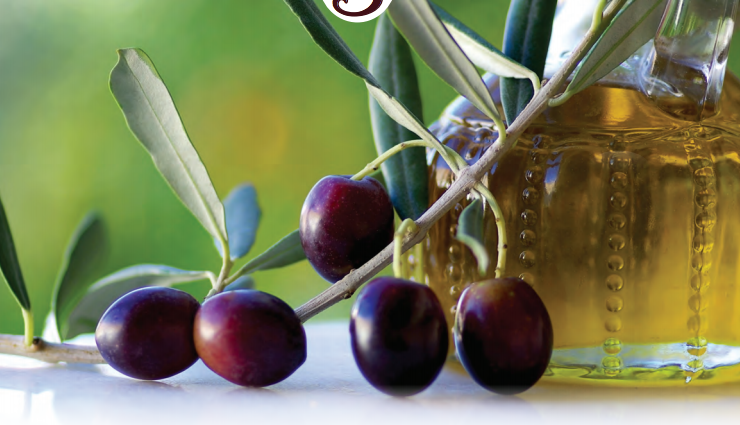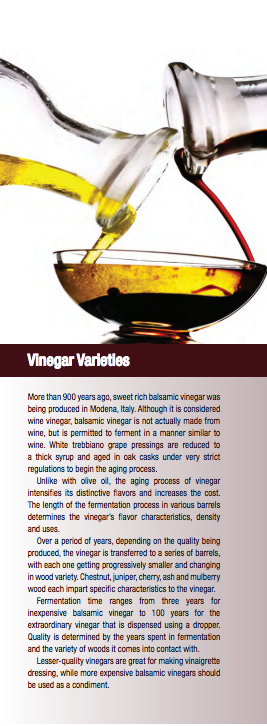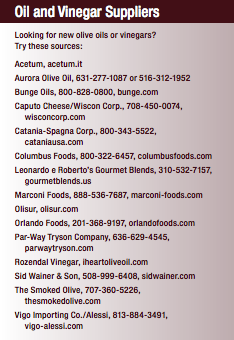
Should I buy virgin or extra-virgin olive oil? What is the difference between an oil’s label stating its content is a “product of” a country, and its saying that the olives were cultivated, harvested and processed into oil in the country of origin? Are the oil’s age, storage and color important? The answers to these
questions can influence what and why you buy, and how you use your olive oil.
The nature of olive oil’s origins, the enthusiasm surrounding it, and its varieties and uses are similar in many ways to those of wine; the olive and the grape even share the same ancient migration pathway. Whether the subject is olive oil or wine, the geography and climate of production—as well as the person doing the harvesting and blending—significantly affect the quality and enjoyment of the product.
The history of the olive tree—its ancient migration from Turkey westward to northern Africa, then into the Mediterranean coastal regions, moving north throughout Italy and Spain, and finally into southern France—is similar to the cultural development of Western civilization. In the mid 1700s, Spanish priests introduced olive trees to Mexican soil, and by the early 1800s, the crop had moved north into California (the United States is a relative newcomer in the cultivation of olive trees and olive oil production). While most countries have adopted the standards for oil quality and purity determined by the International Olive Oil Council (IOOC), the United States has yet to adopt this code, operating instead on the USDA system.
Differentiating Between Oils
Generally, there are two main categories of olive oil. The first includes olive oil extracted directly from the flesh of the olive without using chemical solvents or a reesterification process. This category of oil must not be adulterated by blending with oils from other sources, such as nuts or seeds. Extra-virgin, virgin, refined and pure olive oil are included in this first category. The second oil category is extracted from olive pomace (the leftover olive flesh and pits from the first oil extraction), using solvents and physical treatments.
According to the IOOC’s regulating and grading system, the highest-quality oil—extra-virgin—must be no more than .8% acidity in order to conform to specific processing regulations and pass a rigorous taste evaluation. The oil must be coldpressed and processed through mechanical extraction methods that use no chemicals or heat. The lower the acidity level, the higher the oil’s quality. The higher cost of extra-virgin olive oil is due to traditional harvesting and processing methods, which are time-consuming and labor-intensive. When choosing an extra-virgin olive oil, read the label, as it should tell you where the olives were grown and processed, and its bottling date. Time is another significant factor that separates extra-virgin oil from other oils: Transportation time from the oil’s country of origin to another country for processing and bottling is considerably longer than the 24- to 36-hour harvest-to-pressing time for locally harvested and processed extra-virgin olive oil. As a result, extra-virgin olive oil maintains the integral characteristics of color, taste and aroma, and a maximum of .8% acidity, qualifying it as superior oil.
 Mass-produced olive oils are blended from varying percentages of extra-virgin and refined virgin oils, with a combined acidity level of less than 1.5%. The reduction in purity and higher acidity level are reflected in a less costly product. In response to the rising concern about diet and weight loss, “light” variations of oil are now being marketed; however, these products are not actually lower in calories, but often do lack significant flavor and color due to the refining and extremely low percentage of extra-virgin oil in the blend.
Mass-produced olive oils are blended from varying percentages of extra-virgin and refined virgin oils, with a combined acidity level of less than 1.5%. The reduction in purity and higher acidity level are reflected in a less costly product. In response to the rising concern about diet and weight loss, “light” variations of oil are now being marketed; however, these products are not actually lower in calories, but often do lack significant flavor and color due to the refining and extremely low percentage of extra-virgin oil in the blend.
Olive Oil’s Foes
Heat, age and light are olive oil’s enemies. This evil threesome can increase the acidity level, which causes the oil to become rancid. When shopping for olive oil, take note of where the oil is displayed. Oil stored in a darker area with a green glass bottle is preferable to one stored under a bright fluorescent light and in clear glass. Check to see if a processing date is stamped on the label, and always store your olive oil in a cool, dark spot in your pantry or cellar—definitely not near your stove or in the refrigerator. Storing oil in the refrigerator can cause condensation that drips water into the oil, causing rancidity. And, unlike wine, olive oil does not get better with age. It is common practice to use a one-year-old extra-virgin olive oil strictly for cooking, and use a more recently pressed oil to drizzle over vegetables or grilled steak when you want the oil’s distinctive characteristics to be more dominant in a dish.
Easy Recipes
With the help of the Internet, innovative recipes that use olive oil are only a few keystrokes away. Depending on its flavor, you can use the oil as a condiment, to sauté, or to dress salads.
Creating basic salad vinaigrette is very easy: Whisk together one finely minced shallot, 1 teaspoon Dijon mustard, 1 teaspoon chestnut honey, and 2 or 3 tablespoons balsamic vinegar. Then, very slowly, drizzle in 1/3 cup extra-virgin olive oil, whisking constantly to incorporate. This basic dressing is perfect to top a salad such as tossed arugula greens, sliced roasted beets, chopped toasted walnuts and a few crumbles of room temperature Gorgonzola cheese.
Roasted root vegetables—such as beets, carrots, potatoes (white, sweet or both) and turnips—that have been tossed in a good-quality olive oil are great fall accompaniments to grilled meats. Toss the peeled vegetables with olive oil, then spread on a sheet pan and roast at 350°, until tender. Sprinkle the vegetables with sea salt and pepper after you remove them from the oven. Meanwhile, a tablespoon of balsamic vinegar, plus chopped rosemary or thyme, can be added to olive oil before tossing with yellow summer squash, zucchini and eggplant. Roasted vegetables can be served as part of a room-temperature antipasti platter or as an accompaniment to grilled meat, chicken or fish.
 Try the following recipe for antipasti olives, which make a great appetizer: In a small saucepan, warm ½ cup extra-virgin olive oil over low heat. (It is very important that the oil be only warm—not hot.) Add to the warmed olive oil two or three star anise; several 1”-wide strips of tangerine, lemon or orange zest, with the white part removed; one or two cloves of garlic; and a pinch of red pepper flakes, if you’d like. Remove the mixture from the heat to let the flavors intensify for a half hour. Add 2 cups of mixed-variety rinsed brined olives, and mix together so that the olives are thoroughly coated with the infused oil. Store in a glass jar in the refrigerator, and remove one hour before use so that the mixture comes to room temperature and the flavors release.
Try the following recipe for antipasti olives, which make a great appetizer: In a small saucepan, warm ½ cup extra-virgin olive oil over low heat. (It is very important that the oil be only warm—not hot.) Add to the warmed olive oil two or three star anise; several 1”-wide strips of tangerine, lemon or orange zest, with the white part removed; one or two cloves of garlic; and a pinch of red pepper flakes, if you’d like. Remove the mixture from the heat to let the flavors intensify for a half hour. Add 2 cups of mixed-variety rinsed brined olives, and mix together so that the olives are thoroughly coated with the infused oil. Store in a glass jar in the refrigerator, and remove one hour before use so that the mixture comes to room temperature and the flavors release.








